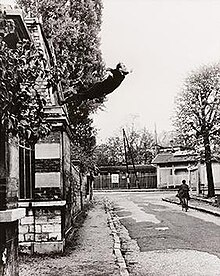created, 2025-02-14 & modified, =this.modified
rel: A Field Guide to Being Lost by Rebecca Solnit Islands
 Yves Klein was a French artist, who was the founding meember of the movement Nouveau réalisme (new realism). He was a pioneer in performance art, and minimal art.
Yves Klein was a French artist, who was the founding meember of the movement Nouveau réalisme (new realism). He was a pioneer in performance art, and minimal art.
At 19 he an his friends divided up the world between themselves. On chose earth, the other words, while Klein chose the ethereal space surrounding the planet.
Music
Klein composed Monotone Symphony, a single 20-minute sustained D major chord followed by 20-minutes of silence.
Roland Dahinden said that “You can’t really do a full rehearsal of something like this” because “It’s too hard. Everyone would just die.”
Art
Klein used color as thought it could be an explicit and overtly political tool for ending wars.
In 1957, Yves Klein painted a globe his deep electric blue, and with this gesture it became a world without divisions between countries, between land and water, as though the earth itself had become sky, as though looking down was looking up. In 1961, he began painting relief maps this same trademark blue, so that the topography remained but the other distinctions vanished.
What was marked Terra Incognita was also what remained unvanquished. Painting the world blue made it all terra incognita, indivisible and unconquerable, a ferocious act of mysticism.
From a news clipping, “Today anyone who paints space must actually go into space to paint, but he must get there without any faking, and neither in an airplane, a parachute, nor a rocket: he must go there by his own means, by an autonomous, individual force: in a word, he must be capable of levitating.”
Blue Paintings
From the reactions of the audience, he realized that…viewers thought his various, uniformly colored canvases amounted to a new kind of bright, abstract interior decoration. Shocked at this misunderstanding, Klein knew a further and decisive step in the direction of monochrome art would have to be taken…From that time onwards he would concentrate on one single, primary color alone: blue.
The buyers would go through the gallery, observing each canvas and purchase the one that was deemed best in their own eyes specifically. Klein’s idea was that each buyer would see something unique in the canvas that they bought that other buyers may not have seen. So while each painting visually looked the same, the impact each had on the buyer was completely unique.
Void
rel:Holes
The Specialization of Sensibility in the Raw Material State into Stabilized Pictorial Sensibility, The Void): he removed everything in the gallery space except a large cabinet, painted every surface white, and then staged an elaborate entrance procedure for the opening night: the gallery’s window was painted blue, and a blue curtain was hung in the entrance lobby, accompanied by republican guards and blue cocktails. Thanks to an enormous publicity drive, 3,000 people queued up, waiting to be let into an empty room.
Klein presented his work in forms that were recognized as art—paintings, a book, a musical composition—but then would take away the expected content of that form (paintings without pictures, a book without words, a musical composition without in fact composition) leaving only a shell, as it were.
Klein wanted his subjects to be represented by their imprint: the image of their absence.